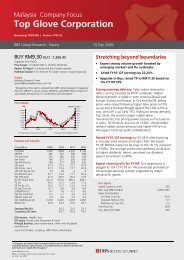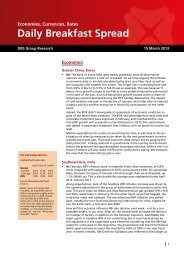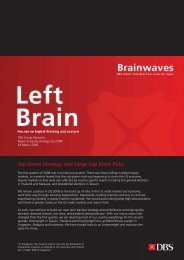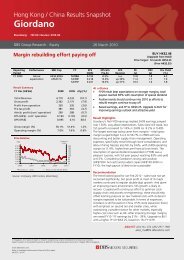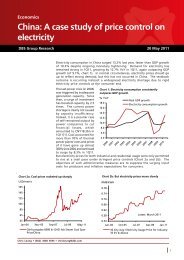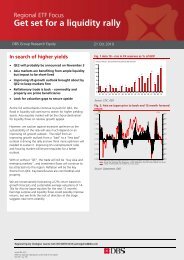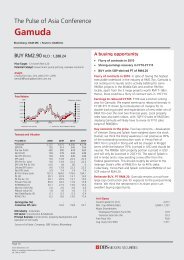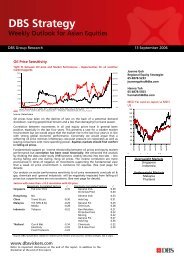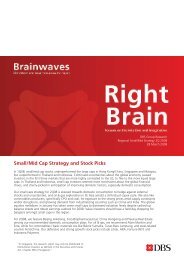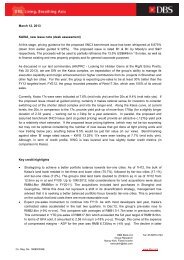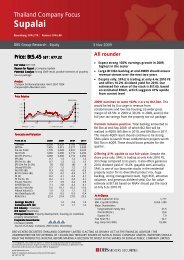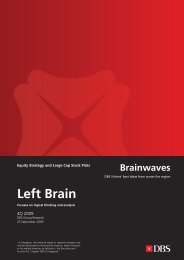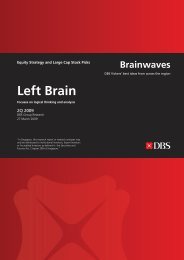Economics Markets Strategy - the DBS Vickers Securities Equities ...
Economics Markets Strategy - the DBS Vickers Securities Equities ...
Economics Markets Strategy - the DBS Vickers Securities Equities ...
You also want an ePaper? Increase the reach of your titles
YUMPU automatically turns print PDFs into web optimized ePapers that Google loves.
Currencies<br />
<strong>Economics</strong> – <strong>Markets</strong> – <strong>Strategy</strong><br />
USD/MYR<br />
forecast, eop<br />
Latest Prev<br />
Close 3.27 3.18<br />
2Q08 3.27 3.25<br />
3Q08 3.30 3.15<br />
4Q08 3.35 3.00<br />
1Q09 3.40 3.15<br />
2Q09 3.45 3.14<br />
3Q09 3.40 3.14<br />
4Q09 3.35 3.13<br />
BNM o/n policy rate<br />
forecast, eop<br />
Latest Prev<br />
Close 3.50 3.50<br />
2Q08 4.00 3.50<br />
3Q08 4.00 3.50<br />
4Q08 4.00 3.50<br />
1Q09 4.00 3.50<br />
2Q09 4.00 3.50<br />
3Q09 4.00 3.50<br />
4Q09 4.00 3.50<br />
Latest close on Jun 11<br />
Prev close on Mar 12<br />
Malaysian ringgit – dominated by political uncertainties<br />
As predicted in our previous quarterly, <strong>the</strong> appreciating MYR corrected in 2Q08.<br />
The MYR appreciated to 3.1280 against <strong>the</strong> USD on Apr 23, its strongest level<br />
since Oct 1997. Like o<strong>the</strong>r Asian currencies, <strong>the</strong> MYR succumbed to a stronger<br />
USD on market expectations for <strong>the</strong> US to start taking back its rate cuts as early<br />
as 4Q08. Domestically, <strong>the</strong> MYR was also undermined by post-election political<br />
uncertainties, <strong>the</strong> key risk confronting <strong>the</strong> MYR this year<br />
Uncertainties emerged after <strong>the</strong> ruling Barisan Nasional (BN) coalition lost its<br />
two-thirds parliamentary majority at <strong>the</strong> general elections held on Mar 8. The<br />
coalition also ceded control of 5 out of <strong>the</strong> 13 states to <strong>the</strong> opposition. Since<br />
<strong>the</strong>n, PM Abdullah Badawi has been facing increasing pressures to step down.<br />
His predecessor, Mahathir Mohamad, quit <strong>the</strong> United Malaysia National Organization<br />
(UMNO) on May 20 in protest of Badawi’s leadership. Oppositon leader Anwar<br />
Ibrahim declared his intention to seize power by persuading BN lawmakers to<br />
defect to his coalition. Anwar is hoping that <strong>the</strong> unpopular fuel price hikes<br />
would hasten <strong>the</strong> fall of <strong>the</strong> BN coalition. For now, <strong>the</strong> prime minister’s fate is<br />
expected to be decided at <strong>the</strong> UMNO annual congress due in Dec 2008.<br />
Adding to political uncertainties here is <strong>the</strong> government’s decision to reform<br />
fuel subsidies on Jun 4. While this is positive for cushioning Malaysia’s fiscal<br />
finances against record high international energy prices, <strong>the</strong> subsequent 41%<br />
jump in petrol prices and 63% rise in diesel prices are likely to add to inflation.<br />
To ease <strong>the</strong> pain on consumers, <strong>the</strong> government intends to widen <strong>the</strong> social<br />
safety net for <strong>the</strong> poor, encourage government department to save costs, widen<br />
<strong>the</strong> list of price-controlled items and make a decision by August whe<strong>the</strong>r to<br />
reduce road toll rates.<br />
Politics aside, we do expect <strong>the</strong> fuel price hikes to lift inflation to 5.8% YoY in<br />
Jun08. Inflation has already doubled to 3.0% YoY in Apr08 from 1.4% in Jun07.<br />
Hence, Bank Negara Malaysia (BNM) is now expected to hike its overnight policy<br />
rate by 50bps to 4.00%, which will be its first rate move since May 2006.<br />
As for <strong>the</strong> MYR, <strong>the</strong> KL stock market index will become an important gauge of<br />
investor sentiment to domestic politics. In <strong>the</strong> end, we expect BNM to maintain<br />
control of <strong>the</strong> exchange rate and keep <strong>the</strong> MYR aligned to Asian currencies.<br />
Without <strong>the</strong> political uncertainties, <strong>the</strong> MYR would have been a strong currency.<br />
Unlike many of its Asian peers, Malaysia’s trade surpluses are not threatened by<br />
costlier energy imports, thanks to its net oil exporter status. In its latest semiannual<br />
currency report, <strong>the</strong> US Treasury considers <strong>the</strong> MYR an undervalued currency<br />
based on its large current account surpluses and low domestic investment.<br />
MYR is no longer ignoring downside risks in stocks<br />
1700<br />
1600<br />
1500<br />
1400<br />
1300<br />
1200<br />
1100<br />
1000<br />
900<br />
USD/MYR<br />
(inverted, rhs)<br />
KL Composite<br />
index (lhs)<br />
3.10<br />
3.20<br />
3.30<br />
3.40<br />
3.50<br />
3.60<br />
3.70<br />
3.80<br />
Trade surpluses held up against record oil prices<br />
MYR bn<br />
12<br />
10<br />
8<br />
6<br />
4<br />
2<br />
0<br />
-2<br />
800<br />
Jan-05 Jan-06 Jan-07 Jan-08<br />
3.90<br />
-4<br />
96 97 98 99 00 01 02 03 04 05 06 07 08<br />
36



